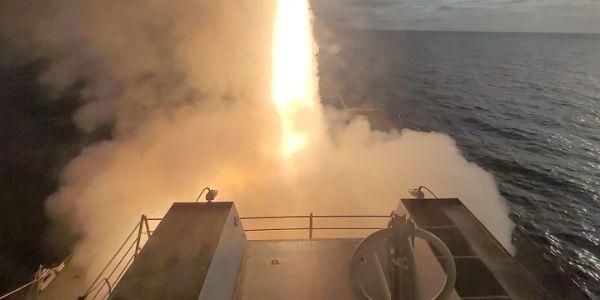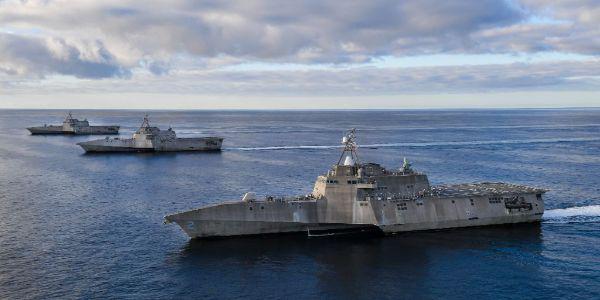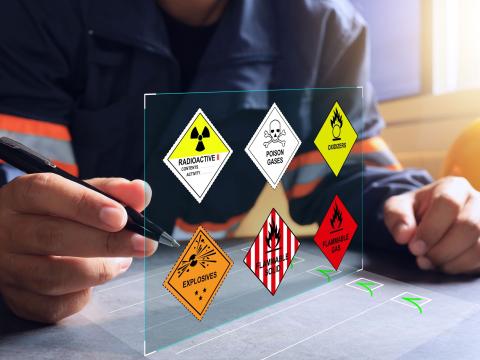Innovation Drives Naval Integration
Back to basics may be the mantra for integrating innovation into the U.S. Navy. The long-held goal of network-centric warfare is more important than ever, and standards definition may hold the key for successful naval innovation.
The need for innovation is emphasized by advances by peer adversaries around the world. To keep up with ever-increasing challenges, the Navy is looking toward new weapons, unmanned systems and advanced dataflow to unify its operations against potential foes’ growing capabilities.
Michael Stewart, deputy director, integrated warfare (N9IB), allows that the Navy must balance the need to speed innovation to the force against practical and budgetary concerns. “What we’re trying to do is understand the problem and realize that the fight is going to be very different, and then take a look at the problem and the fleet that we have and say, ‘Does that make sense? Are there some technologies or capabilities we need to dispense with because they’re no longer relevant?’” he says.
“My suspicion is that we’ll have to divest stuff and invest in new stuff,” he replies.
And the top priorities for “new stuff” in the Navy are long-range fires and unmanned systems, Stewart offers. These two can be complementary, he adds.
Being able to integrate them poses a series of challenges. At the top of the list are standards, as most of the existing weapon and unmanned systems were not made to integrate. Long-range fires largely exist in closed kill chains—a missile fired by an F-18, for example. With standards that permit full integration of these different systems, the kill chain can become a kill web, Stewart offers.
Having integrated warfare means thinking beyond a traditional platform-weapons pairing, Stewart offers. Currently, that entails long-range kill chains and long-range weapons. “If you look at the way the Navy is pivoting, it’s being able to ensure that we can be highly distributed and still interconnected [providing] mass effects when we need them,” he states. “From a kill chain point of view, I want to make sure I can complete kill chains.” Achieving this also depends on the data that needs to be passed and the targeting solution, Stewart adds.
But a single linear kill chain could give way to a kill web when platforms are communicating and are aware of what others are doing, Steward notes. The data is leaping from path to path, choosing the best way to exchange information. He analogizes this to a person using a cellphone on the move while unaware which path the signal is selecting to use to carry messages.
The Joint All-Domain Command and Control system, or JADC2, is helping shape the Navy’s approach to integration, Stewart offers. “It’s forcing people to think really critically about the technologies required,” he says. “It’s contextualizing it and showing … what all those things actually mean.”
For example, unmanned systems will impose a bandwidth tax on the system, so planners must ensure that there is a network for them to plug into when they actually show up, he allows. This network must have the right standards and the right bandwidth.
The extent to which unmanned systems will change the Navy remains to be determined, as many variables and options loom. “There are a lot of unmanned champions, but I can feel myself as ‘the why and so what,’ the lines of reality,” Stewart says. He continues that people put out arguments and businesses cases for unmanned systems being able to attain advanced capabilities, but hurdles to full autonomy remain. Standards and norms will play a role in determining the art of the possible with unmanned systems. “We have ideas of what we can do with them, but what we want to do and what we can do are two different things,” he warrants.
Stewart relates that when he served in the Navy in the mid-1990s, the late Vice Adm. Arthur Cebrowski, USN, was leading the charge toward network-centric warfare. Now, 25 years later, the Navy is still talking about it. It remains to be attained, but now the Navy is being disrupted and is focused on it. Once consigned to the background, the concept of network-centric operations today is in the foreground. As a result, old ways of doing business may have to go by the wayside.
“I’m awash in technology. I’m awash in strategies. What I’m not awash in is money,” Stewart states. “The way I look at this is, when I have an existing legacy fleet that is very expensive to maintain, how do I find the money to fund innovative technologies and really experiment with them?” He continues that he seeks input from technology experts from groups such as the Office of Naval Research and the Defense Advanced Research Projects Agency for their advice on solving challenges. Even when they bring in technology that suits the Navy’s needs, the service begins with small-scale prototyping and moves forward from there to concept development.
Ultimately, the warfighter determines if a new technology approach fits service needs. “What I’m seeing in innovation right now … is crossing the chasm from technology development to adoption,” Stewart allows. “You’ve got to make it relevant to a warfighter, and you’ve got to have a fairly compelling business case.
“What I’m trying to prevent is people just showing up with all sorts of interesting technologies without any clear understanding of how it’s relevant to a warfighter,” he declares.
Stewart relates that his office created a war room to deconstruct the National Defense Strategy for the chief of naval operations’ planning guidance, the joint warfighting guidance and the tri-service maritime strategy. By breaking down all of these guidances, the office would determine how the fight would actually take place. These experts found that, in some cases, the Navy was focused on the legacy fleet with incremental innovation. However, when the office tapped the outside experts, it established a strong dialog between the warfighter and the technologist and focused on greater relevancy to real requirements.
“I view this as not a technology problem but as a transformation problem and a business problem,” he maintains. “I could have all the greatest ideas in the world, but as you follow that all the way through the budgeting cycle, your thing has to compete to win.” He adds that funding must be found in the existing budget by shifting resources from other areas. The key is to establish tight linkage between technology expert and the warfighter to show that the innovation would be a targeted investment and not a game of chance.
Advances by adversaries are driving many of the needs for innovation integration in the Navy. Stewart notes that some adversaries are trying to keep the Navy at bay and deny area access through a combination of sensors and weapons. “We had a lot of freedom of maneuver in the Middle East—we owned the skies, we could get as close as we wanted to get and logistics wouldn’t work hard—and now that potentially could be changing,” he posited. “We have to re-think that.”
Being able to fight at a long distance means distributed maritime operations. Again, standards are the key to ensuring that different systems can interoperate and pass data.
Autonomous systems are moving into naval operations in greater numbers, but Stewart warns against blind enthusiasm for them. “A lot of people are saying that we should use autonomous systems, so the first question I want to know is, ‘Why? What’s the business case for them?’” he says. If they are economical and effective, the next step is to lower the barriers of entry for nontraditional players to generate a competitive marketplace.
They will require a great deal of integration, so issues such as autonomy data transfer standards must be resolved. “Who should own the autonomy? Should the government own it and have data rights?” he asks. Right now, he is inclined toward government ownership of the autonomy so it can be attached to whatever platform needs it. The Navy is working toward that approach to bring others into a standards-based environment.
But determining the level of autonomy in the process is a challenge. Stewart offers that his office can buy some level of autonomy commercially, while a further degree of autonomy must be developed by the military or the Defense Department. Developing that additional autonomy, determining its cost and establishing a timeline all must be taken into account.
WEST 2021, the premier naval conference and exposition co-sponsored by AFCEA International and the U.S. Naval Institute, will take place virtually June 29-30. Visit the website for the latest information and to register.






Comments